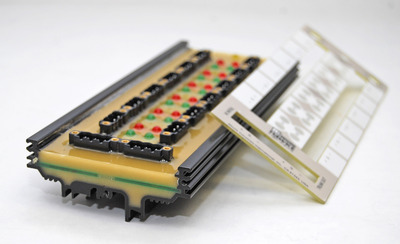Fieldbus device couplers simplify chemical plant upgrade
Ashland Inc is a global leader in providing specialty chemical solutions to customers in a wide range of consumer and industrial markets. The company includes four commercial units - Ashland Specialty Ingredients, Ashland Water Technologies, Ashland Performance Materials and Ashland Consumer Markets - serving customers in more than 100 countries.
In August 2011, Ashland purchased International Specialty Products Inc (ISP), which had acquired BP’s 1,4-butanediol (BDO) production operation in Lima, Ohio six years earlier. The plant has an annual capacity of 65,000 metric tons of BDO, an intermediate ingredient in common industrial and commercial products. BDO is reacted to make items such as engineering plastics, polyurethane systems (eg, golf balls, skateboard wheels, car bumpers) and as carrier solvents in printing inks and cleaning agents.
The Lima plant’s integrated butane-to-butanediol production process combines catalytic oxidation of butane in air with fixed-bed fatty acid hydrogenation technology. The facility processes butane and air to maleic acid in a fluidised bed reactor, and maleic acid to BDO in a high-pressure, H2-rich, fixed-bed hydrogenation reactor. It also utilises an off-gas boiler for steam and environmental compliance.

The Lima plant called on Emerson Process Management to supply a DeltaV distributed control system (DCS) using the Foundation fieldbus protocol. As part of the Foundation-based automation architecture, proportional-integral-derivative (PID) control algorithms are located in a majority of the digital valve controllers. In addition, all dual-element transmitters are equipped with onboard signal-select blocks. A total of 80 fieldbus H1 (31.25 kbps) segments connect approximately 600 fieldbus instruments and valves, handling 150 control loops.
The facility’s original 400 discrete I/O devices (mostly on-off valves) were wired directly to process controllers, which have since been supplemented with dozens of fieldbus-capable on-off valves. The system also includes approximately 400 emergency shutdown I/O and 200 resistance temperature detectors and motor statuses integrated through Modbus multiplexers.
With this configuration, the entire fieldbus architecture (with the exception of emergency shutdown functions) is covered by a single operating system.
In October 2012, Ashland embarked on an upgrade of the Foundation fieldbus system. The scope of work, completed during a three-week planned outage, involved enhancements to the existing DeltaV system, as well as replacement of legacy terminal blocks, instrument wiring, power supplies and other fieldbus physical layer components on 60 device segments throughout the facility.
At the time of the plant’s construction in 1999, device coupler technology did not exist. Control system designers had to rely on terminal wiring blocks, which didn’t offer short-circuit protection or current limiting on spurs. Although this approach was convenient for field wiring, it caused concerns about maintenance activities inadvertently shorting out the segment. When terminal wiring blocks are used in a plant, personnel also cannot perform live work on instruments located in Division 2 classified areas.
An initial solution to this problem was the use of quick-disconnect connectors, which allowed technicians to disconnect devices without unnecessary risk of shorting conductors and shutting down segments. However, electrical code restriction authorities also called for the installation of disconnect switches to comply with hazardous area requirements.
Over the years, many of the disconnect switches became corrupted by corrosion and water, posing an operational liability. This prompted plant engineers to seek a way of replacing legacy hardware on control loops throughout the facility while still maintaining existing area classifications. The work had to be completed in two stages, with the first phase focused on eliminating the switches on the device side of the installation and the second phase devoted to rewiring junction boxes.
John Rezabek, process control specialist at the site, noted that the choice of a device coupler technology was particularly important on the Lima upgrade project since “device couplers touch every valve in the plant.” He and other team members determined that a coupler design incorporating short-circuit protection and providing non-incendive spurs was necessary if the disconnect switches were removed.
During preparations for the control system modernisation, project engineers evaluated a number of alternative fieldbus physical layer technologies based on price, performance and reliability. They ultimately chose to install MooreHawke’s Trunkguard Series 200 (TG200) device couplers.
MooreHawke characterises the TG200, a rugged DIN rail-mounted unit, as a ‘fourth-generation’ device coupler. Starting with early models intended for use with parallel bus wiring, device couplers have advanced from fuses to safeguard fieldbus installations from failure, to current-limiting technology to better protect the device network. However, current limiting places additional load on the bus that can affect other devices.
Moore Industries’ fourth-generation device coupler solves the common issue of segment termination and short-circuit protection with unique capabilities. Employed in rugged metal-clad castings with encapsulated electronics, they provide end-of-line-sensing auto termination and ‘fold-back’ short-circuit protection. Rezabek admitted some trepidation in installing the latest coupler technology, due to its perceived complexity and advanced functionality.

“On the surface, these device couplers have more features than competitive solutions,” he said. “We wondered whether functions like fold-back short-circuit protection and auto-termination would create compatibility issues with power supplies, device couplers and other equipment installed on our existing segments.
“To date, everything has worked as we anticipated. It’s there when you need it, and the rest of the time it goes unnoticed. We’ve been able to mix and match different suppliers’ couplers on our segments without any difficulties whatsoever.”
The new breed of fieldbus device couplers are specifically designed to assist in segment commissioning by eliminating errors associated with segment termination, including failures resulting from over/under termination. They also address the problem of excess current (from a spur short) causing the voltage to drop below the segment threshold of 9 V.
With the auto-termination capability, local devices on a segment continue to function even if remote couplers are accidentally disconnected. This prevents costly downtime and hazardous situations. Segment termination automatically activates when the device coupler determines it is the last fieldbus junction on the segment. If it is, the segment is terminated; if it is not, the coupler doesn’t terminate the segment since the downstream unit will assume that responsibility.
To properly terminate a segment, technicians are not required to take additional actions such as setting DIP switches or disconnecting terminators on one coupler and reconnecting them on another.
Earlier device couplers used short-circuit protection that limited the fault current to a fixed - and always higher - level (50-60 mA) that can cause other devices to fail. The new short-circuit technique detects a short in less than 5 microseconds and removes the device from the segment, using a trickle current to determine when the short has been removed. A red LED confirms the short-circuit condition, making the total current draw between 4-5 mA during a short circuit.
With removal of the short, the spur is automatically reconnected to the fieldbus segment. With this technique, coupler voltage favourably increases for segment devices during spur short circuits.
With the latest form of short-circuit protection, users are also free to place more devices on fieldbus segments. A large industrial process operation may have hundreds if not thousands of devices; if a safety margin is implemented, where the entire capability of fieldbus is not used, the cost of all the extra segments can become substantial.
“Thanks to an increased power budget, you can hook up test equipment without having to account for a short circuit,” said Rezabek. “If I’m building a segment with other types of coupler technology, I have to add another 50 mA of spare power capacity - which is equivalent to two devices worth of current - to account for a potential short-circuit load.”
The TG200 device couplers aid in the process of connecting test equipment. They come with standard handheld hook-up terminals which allow for handheld testing devices to be hooked up simply by connecting the device to the device coupler through the fitted test points.
“The parts of our plant where we performed upgrades were mature, so the auto-terminator capability allowed us to extend segments on the fly as needed,” Rezabek said. “We weren’t worried about adding devices because we knew the segment could be extended while running without disrupting communications.”
Highly precise and safe control of hydrogen testing
With a modular control solution from Beckhoff featuring over 500 data points, Greenlight...
Three strategies that will enable IIoT deployment
A tech insider reveals how the food and beverage industry can take small, strategic steps forward...
Meaningful connections: connectivity challenges in Australia's process automation landscape
Increased connectivity is a pivotal factor in the future of process automation across Australia,...











